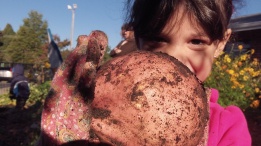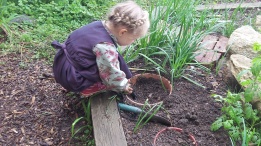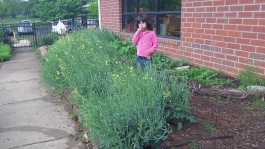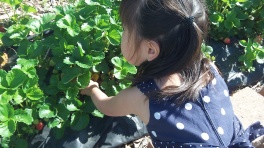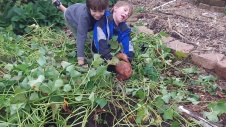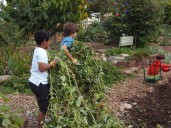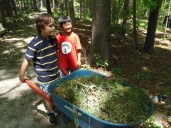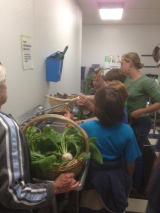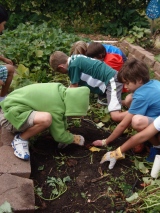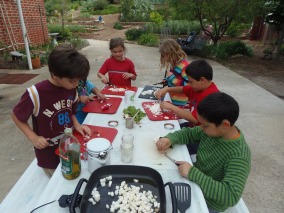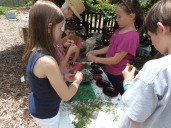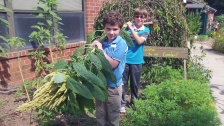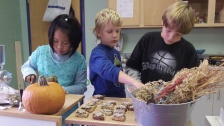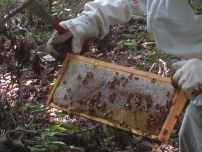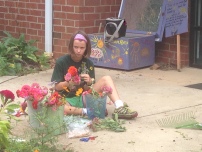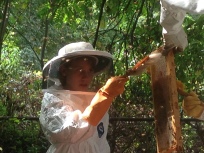Seed to Table
 Many activities that young gardeners will participate in are all part of a greater cycle called the “Seed to Table” cycle in which a seed travels from the soil, to the table, and back to the soil again. The children will watch this life cycle unfold and actively participate in it. Almost any activity that we engage in – be it watering, cooking, planting, or observing life in the garden – is illustrated in the seed to table cycle. It applies to all grade levels and can range from the simplest activities to the most in-depth discussions and practices.
Many activities that young gardeners will participate in are all part of a greater cycle called the “Seed to Table” cycle in which a seed travels from the soil, to the table, and back to the soil again. The children will watch this life cycle unfold and actively participate in it. Almost any activity that we engage in – be it watering, cooking, planting, or observing life in the garden – is illustrated in the seed to table cycle. It applies to all grade levels and can range from the simplest activities to the most in-depth discussions and practices.
Curriculum is also based on seasonal cycles, the garden environment, and the age of the students. We invite spontaneity and often pause to watch and identify insects, marvel at life in the garden, and discuss questions or insights. In all levels we teach about soil, decomposition and compost, pollination, and bio-diversity. The depth and detail of these lessons varies, but these are core concepts that are important throughout the program.
In primary gardening the students:
- Learn to empathize with living things (animals, plants, and each other)
- Connect to the garden/ natural world through song, dance, story, and experience
- Develop fine motor skills and follow instructions as they carefully plant, water, and tend to the garden
- Prepare and taste food from the garden (“impressionable palettes”)
- Experience joy, peace, and wonder in the garden as they learn
There are between ten and twenty “works” that primary students choose from to help them learn fundamental gardening skills. They work with seeds, trowels, watering cans, and the Earth and help plant and tend the garden every week with teachers and volunteers. They learn to identify many of the plants in the garden and know where to locate their favorite treats like “sour flower” (sorrel,) carrots, and fennel – not to mention kale, strawberries, beans, etc.
Click here to see the specific “works” that we have created to follow the child in primary and what a semester with this age group looks like.
In Lower Elementary gardening students:
- Plant, water, weed, and maintain the gardens
- Make trips to the woods to compost weeds and explore their world
- Observe, study, and interact with animals in the garden (birds, worms, toads, slugs, good and bad bugs, etc.)
- Cook with food from the garden and learn to chop, grate, mash, knead, etc.
- Taste and celebrate!
- Keep journals
- Relate science, social studies, and the great works to gardening lessons
The Lower El students explore their environment, experiment, and are very active in maintaining the health and beauty of the gardens. They are able to carry full wheelbarrows, rake, and use the broadfork to prepare beds for planting. They are not only developmentally ready for this work, they also take great joy in doing it, and learn many valuable lessons in the process. They begin to make big connections between food, their environment, and themselves
In Upper Elementary gardening students:
- Plant, water, weed, and help design the gardens
- Turn the compost and learn about decomposition
- Save seeds for propagation
- Prepare and share meals together
- Observe plant and animal life and the importance of diversity in the garden
- Begin to think critically about food systems
In Upper-Elementary gardening, students take a big step, interconnecting physical work, cooperative leadership, environmental stewardship, and academic knowledge to maintain their garden. The garden is a living classroom which highlights local, global, and universal lessons and it burgeons with possibility for students and teachers alike. Each student works to cultivate healthy soil systems, plant seasonally, harvest and cook in cooperative teams, and learn about their ecosystem and how to encourage diversity. Seasonal harvest festivals and collaborative school meals are end of season or semester goals, connecting the culinary arts and farm to fork program. Curriculum includes (but is not limited to): soil building, ecology, nutrition, annual and perennial planting techniques, nature’s seasons, cultural foods and uses, food plant origins, native edible plants, medicinal herbs, harvesting techniques, seed saving, and the study of fruit to flower cycles.

